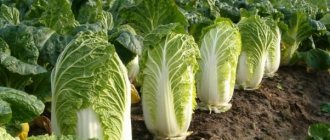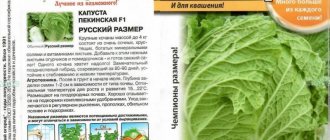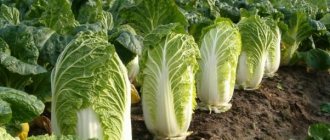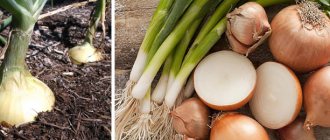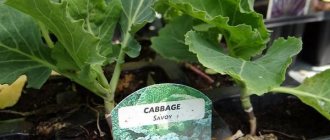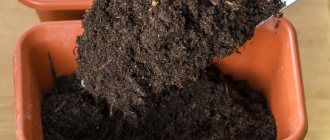In our country, Chinese cabbage is a rather exotic product. And therefore, many gardeners are afraid to experiment with it, preferring more familiar Russian or Dutch varieties. Meanwhile, growing Pekinka at home does not require serious effort or special knowledge. If you take into account when it is best to sow seeds and when to harvest Chinese cabbage, then if you wish, you can harvest from the garden even twice a year.
Beijing cabbage in the garden
Varieties of Chinese cabbage
There are a huge number of varieties of Chinese cabbage in the world selection. The harvest of such vegetables can be obtained in any climate zone, but subject to certain rules.
For example, early varieties feel better in greenhouses. In the southern regions of our country, it is necessary to shade plants, which will create a shortened daylight hours.
Next, let's take a look at the most popular varieties of Chinese cabbage:
Victoria
An early ripening variety, it has excellent taste and a pleasant aroma. The fruits are used for preparing salads and other dishes and are suitable for heat treatment. Vegetables are cylindrical in shape, elongated with dense, loose leaves of light green color. The growing season for the Victoria variety is within 2 months.
Orange Mandarin
An early ripening variety that can be grown throughout the warm period. Under favorable weather conditions, the fruits of the crop ripen 40 days from the moment the seedlings are planted in open ground. The heads of cabbage are small, their weight does not exceed 1 kilogram. The variety tolerates stressful situations and is suitable for cultivation in Siberia.
Marfa
A shade-tolerant, early-ripening variety with a growing season of 40-42 days. This cabbage has fairly large and wide leaves and tasty pulp. The maximum weight of a head of cabbage is 1.5 kilograms. Sowing seeds for seedlings is carried out in the second ten days of April; grains are sown in open ground from mid-May.
Pomegranate
Mid-season variety, has large fruits weighing up to 2.5 kilograms. The heads of cabbage are elongated in shape and have tightly fitting dark green leaves. Pomegranate exhibits resistance to many diseases, especially necrosis. The first cabbage harvest is obtained 70-75 days after sowing the seeds.
Express
The variety is suitable for growing in greenhouses and open ground. This is an unpretentious plant, resistant to sudden temperature changes. The heads of cabbage are bright green in color, weighing up to 2 kilograms. Beijing Express can be used for cultivation in Siberia.
Stonefly
An ultra-early variety, ripens 35 days from the moment the seeds are sowed in the greenhouse. The heads of cabbage are small, juicy, suitable for making salads.
Wineglass
The mid-late variety with a growing season of 70 days is quite difficult to care for, so it is better to grow this vegetable in the southern part of our country. The heads of cabbage are dense, weighing up to 2 kilograms.
Negative temperatures
Frost has different effects on different varieties and varieties of this crop. Some are able to withstand down to minus 10 degrees, others cannot tolerate even minus 1, they begin to become fragile, get sick and require urgent rehabilitation. Therefore, it is difficult to give an exact answer whether cabbage is afraid of frost, since it is all individual.
What negative temperature conditions can cabbage withstand?
- During the development period, white cabbage can withstand up to 5 degrees of frost. If the temperature is lower, the yield will be significantly worse. Before harvesting, a formed head of cabbage can hold up well even at minus 10;
- Chinese cabbage (seedlings) tolerates temperatures down to minus 2 degrees. A fully formed (adult) plant can withstand frosts down to minus 5 degrees;
- Cauliflower is not so resistant; at any stage of development it can withstand up to 2 degrees of frost and no more than 2-4 days;
- Broccoli in the seedling stage of development, if the spring is cold, can well tolerate temperatures of minus 2 degrees. An adult plant of the crop feels normal at minus 5 degrees.
Cabbage, especially white cabbage varieties, tolerates frost well, so today it can be seen on the plots of gardeners and summer residents in almost all regions of the country, even in the Arctic. What negative temperatures cabbage can withstand at different stages of development is mentioned above.
Such a phenomenon as frost is not a pleasure for gardeners during spring planting or before harvesting. How to reduce possible losses, and how many degrees cabbage can withstand frost at the seedling stage of development, is outlined in this article.
How to properly grow Chinese cabbage seedlings
The cultivation of the crop in question can occur using seedling material or by directly sowing seeds in open ground. Chinese cabbage is considered a cold-resistant plant; its grains can form sprouts at an air temperature of +4-5 degrees, but intensive development is possible in the range of +15...+22 degrees. When warming occurs, the crop throws out inflorescences. This phenomenon often occurs in conditions of extended daylight hours.
Due to the need for shortened daylight hours, it is recommended to grow the crop from seedlings in early spring or late autumn. Sometimes it is advisable to create a special lighting regime. In this case, the first fruit harvest is obtained within a month from the moment the plants are planted in open ground.
Methods of frost protection
The main ways to protect plants from spring and autumn frosts are:
- Smoking is the most ancient method, which involves lighting fires at different points in the area. The resulting warm smoke screen softens the negative impact of lower temperatures on seedlings. Smoking is carried out exclusively in calm weather, so that the smoke spreads close to the ground and maintains a warm protective layer of air. They start lighting fires already at 0°. Now this method is being abandoned everywhere, because... it has been proven to be unsafe and not environmentally friendly.
- Sprinkling is one of the most common ways to protect plants from freezing. Sprinkling involves uniformly spraying the plantings with warm water through a fine sprayer. As the water freezes, the heat needed for seedlings will be released. This method is effective only in calm weather at temperatures down to -3-4°. In strong wind conditions, sprinkling will only harm the plants. Before frost sets in, you can water the soil so that the sun's rays heat the moist soil during daylight hours, and at night it gives off heat and creates a favorable microclimate for the seedlings.
- Creating a thermal insulation layer - covering plants with newspapers, cardboard, fabric to retain heat. The more layers are created, the more reliably the seedlings will be protected from the cold. The covering material should not come into close contact with the sprouts; it is imperative to maintain an air gap. The thermal insulation layer will make it possible to survive a drop in temperature (below 0°) for up to a week.
- Foliar fertilizing with fertilizers containing potassium and phosphorus is an effective means of withstanding cold (down to -5°). To increase the winter hardiness of plants, fertilizers should be applied at least a day before the onset of cold weather.
Frozen bushes must be hidden from bright sunlight so as not to aggravate their condition. It is recommended to treat them with Epin or Zircon solutions to speed up recovery.
When to plant Chinese cabbage for seedlings
Planting seed material of Chinese cabbage should be carried out about a month before the intended planting of seedlings in a permanent place. To obtain an early harvest, seedlings are sown in the last ten days of March or early April. When growing seedlings to obtain a harvest for winter consumption, sowing of grains is carried out at the end of June.
Preparing seeds for planting
Purchased Chinese cabbage seeds do not require special preparation; they can be immediately planted in the ground without prior soaking. If you use your own seed material, the grains need to be pre-germinated, which will allow you to determine their germination capacity.
To do this, they are placed on wet gauze folded in several layers. Next, place the container with the seeds in a warm place and wait for the sprouts to appear. Their germination begins 3-5 days from the moment of sowing.
If this does not happen or seedlings are rare, you need to take other seeds.
Preparing the soil for sowing
In practice, several options for soil mixtures are used for sowing Chinese cabbage seedlings:
Soddy soil and peat in equal proportions with the addition of 10 grams of wood ash and complex mineral fertilizer (for every 10 kilograms of the mixture).
2 parts humus and 1 part coconut substrate.
Sowing seeds for seedlings
The crop in question does not survive transplantation well, so the seeds should be sown not in a common box, but in peat pots (2-3 grains per container). The seed material is buried in the nutrient substrate to a depth of 1.5 centimeters. After this, the seedling containers are installed in a warm but dark place until seedlings emerge.
Seedling care
After the first shoots appear, the seedlings are moved to a well-lit windowsill. At this stage of development, the room temperature must be maintained at +7...+8 degrees. A loggia or glazed balcony is best suited for this.
Further care of the seedlings consists of periodic watering with warm, settled water. The soil should be moistened as the top layer of the nutrient substrate dries. After carrying out these procedures, it is necessary to carefully loosen the soil, which will prevent moisture stagnation.
When the seedlings have two or three true leaves in the pot, leave one of the healthiest plants and pinch out the rest.
Dive
We have already said earlier that Chinese cabbage seedlings do not tolerate transplantation well, so the seeds are sown immediately in separate containers. This allows you to bypass the dive process.
How to transplant Chinese cabbage seedlings into open ground
Chinese cabbage seedlings are moved into open ground along with peat pots. In the future, these containers will dissolve and provide additional nutrients for plant development.
It is recommended to transplant seedlings to a permanent place in the phase of appearance of 5-6 true leaves (approximately three weeks from the moment of emergence).
10 days before the expected planting date, the plants are hardened off in the open air, gradually increasing the time. Seedlings can be planted in a permanent place after they have spent a day outside.
Planting scheme
There are several schemes for planting Chinese cabbage in open ground:
- If the plant is used as a salad crop, a distance of 25 centimeters is left between individual seedlings in both directions.
- To form a head of cabbage, you must follow the pattern of 35*35 or 50*50 centimeters.
This requirement is valid for sowing vegetables directly into open ground.
When using seedlings, follow the 30*50 centimeter pattern.
To get a good harvest of fruits and prevent bolting, planting the vegetable should be done in early spring or autumn.
Sowing seeds in the ground
To grow Chinese cabbage without seedlings, you need to choose the right site. The ideal predecessors of the culture in question are:
- onion;
- garlic;
- carrot;
- cucumbers
It is not advisable to sow grains in soil where close relatives of cabbage (mustard or radish, radish) had previously developed.
Seeds are sown in previously dug soil. Planting holes are made in the garden according to a pre-selected pattern of 35*35 or 50*50 centimeters. 10-15 grams of wood ash and 0.5 kilograms of organic matter (compost or humus) are added to each hole.
Next, the nutrients are thoroughly mixed with the soil and seeds are sown, 2-3 per hole. Now you need to water the soil with warm water and cover the area with plastic film.
After a week from the moment of sowing, shoots should appear. At this moment, the most developed sprout should be left in the hole, the rest should be pinched.
Planting dates for Chinese cabbage
The time for sowing seeds in open ground depends on the air temperature. The ideal conditions for the development of this cabbage are considered to be a temperature of +16…+22 degrees. Exceeding or decreasing the recommended values leads to the formation of peduncles.
For the seedless method of cultivation, two favorable periods for sowing seeds are used: April 25 to May 5, June 25 to July 15.
Caring for cabbage in the garden
Growing Chinese cabbage requires the gardener to follow certain rules. Newly planted seedlings must be covered with agrofibre or any other non-woven material. This allows:
- protect crops from possible frosts or sudden temperature changes;
- shades plants from the scorching rays of the sun;
- protects the root system of cabbage from rotting during periods of prolonged rain;
- allows you to hide seedlings from pests, cruciferous flea beetles.
Two weeks after planting the seedlings in the garden bed, the area is covered with mulch made from broken straw and peat. There is no need to hill up the crop; a thick layer of organic matter will retain soil moisture and prevent the growth of weeds.
Further measures for caring for cabbage include periodic watering and fertilizing, identifying and protecting vegetables from diseases and pests.
Watering and fertilizing
Chinese cabbage needs regular, abundant watering. It is recommended to moisten the soil once a week using warm water. The liquid should be poured under the root of the plant.
Water contact with leaves causes sunburn.
For better plant development, watering should be done in the morning or in the evening after sunset. In the latter case, it is recommended to use warm water infused throughout the day.
The first fertilizing is applied to the soil two weeks after planting the seedlings. The following solutions can be used for this purpose:
- 10% mullein infusion (1 kilogram per 10 liters of water);
- 5% infusion of bird droppings (500 grams of organic matter per 10 liters of liquid);
- infusion of herbs or nettles.
When fertilizing cabbage with fertilizers, 1 liter of solution is used for each bush. For spring crops, three such feedings are necessary. Plants planted in summer are fed twice during the growing season.
Foliar fertilizing also helps improve the yield of Chinese cabbage. To prepare such a substance, dilute 2 grams of boric acid in a liter of boiled hot water, then bring the volume to 10 liters with cold water. Treatment of crops is carried out in the evening on the leaves.
Harvesting and storing Chinese cabbage
To improve preservation and prevent the development of rot, it is recommended to cut the heads of cabbage in dry weather. The collected fruits are stored in a cool and dry room with a temperature range of 0…+2 degrees. Vegetables are laid out on racks or packed in boxes.
Carry out periodic inspection of the heads of cabbage for dried leaves and rotten areas.
Recommendations for harvesting
Chinese cabbage harvest
By the time the heads ripen, it is important to choose the correct timing for harvesting the vegetable. As a rule, this moment comes when the leaves of the pekinka and the head of cabbage are already fully formed, but the arrow and inflorescences have not yet begun to appear.
Leaves for salad or other dishes are trimmed during the process of forming a head of cabbage. They are cut off as they grow to 10–12 cm. Moreover, this is often done partially, leaving a growth point. In this case, after some time the leaf grows back. Be sure to trim the leaves from the main bush in the spring, when the heads are planted close to each other and interfere with normal watering and fertilization.
The heads are harvested when they are fully ripe, depending on the variety. The weight of the head of cabbage must be at least 1.2 kg. They are cut off almost to the very base of the head, but so as not to damage the covering sheets. If the Peking tree is replanted, the crop is harvested in the fall before the first frost.
Important! For cleaning, choose a dry, cool day. 3-4 days before this, completely stop watering the plant. The roots remaining in the ground are carefully removed following the heads of cabbage.
Diseases and pests of lettuce
Chinese cabbage, like other cruciferous vegetables, can be affected by various diseases and pests during the growing season.
First, let's get acquainted with the main diseases of this vegetable:
- Blackleg affects emerging sprouts of cabbage seedlings. The main symptom of the disease is blackening and narrowing of the crop stem, which makes it difficult for nutrients to reach the leaves and causes plant death. To prevent the development of blackleg, you need to disinfect the soil and seed material and follow the rules for caring for seedlings. The development of this disease is promoted by low temperatures and high air humidity, as well as dense plantings of young plants.
- A bacterial disease of clubroot causes thickening to appear on the root system of cabbage. As a result of this effect, the cells become deformed and do not allow nutrients to pass through easily. The affected plant turns yellow and begins to dry out. The development of the disease is facilitated by high soil moisture and low-quality seeds, as well as acidic soil. To prevent the development of the disease, before planting seedlings, the soil is calcined in the oven and then spilled with a solution of potassium permanganate. Wood ash or lime is additionally added to acidic soil.
- The fungal disease gray mold affects the aboveground part of the crop during the period of fruit ripening or during storage. Symptoms of the disease are the appearance of brown spots on cabbage leaves. After some time, a grayish coating forms on the affected areas. Spraying the plantings with fungicides, for example, Amistar, will help defeat the disease.
Among the pests that affect Chinese cabbage are:
- Small bugs, fleas. These insects jump on the leaves and suck the juices out of the plant, which leads to slow wilting and stunting of the crop. Flea beetles are especially dangerous for young cabbage with tender leaves. These parasites must be eliminated immediately at the first sign of their presence. To spray plantings, you can use preparations such as Karate or Decis.
- The cabbage cutworm parasitizes plants in the form of a caterpillar. At first the larvae are yellow, then their color changes to green. Caterpillars live on the outside of leaves and chew them until holes appear. As a result of the vital activity of parasites, excrement appears on the cabbage, which provokes the appearance of putrefactive areas. The crops are processed from May to June, using chemicals such as Festal, Karate, Decis. Cabbage cutworm pupae overwinter in the upper layers of the soil. To destroy them, deep autumn plowing of the bed is necessary.
Chinese cabbage is considered a fairly demanding plant to care for. To get such vegetables you need to have basic knowledge of growing them. Put our tips into practice and you will get a good harvest of Chinese cabbage.
Preliminary preparation
Site selection
Chinese cabbage needs good soil rich in organic matter. Due to rapid growth, medium loamy and sandy loam soil is best suited for cultivation. This is due to the fact that they retain moisture well and most have a neutral soil reaction. The ideal acidic environment for Beijing is pH 6-7.
If we talk about more acidic soils, then they are also suitable, but with the condition of mandatory liming.
It is necessary to avoid the development of diseases that are especially dangerous for cabbage - clubroot, downy mildew.
Accordingly, sandy soil is the worst choice for Beijing, as it dries out quickly and does not provide cabbage with important mineral components.
The site must be chosen with good lighting, it is important to fertilize and, if necessary, lime it in advance.
Chinese cabbage is a light-loving plant
Predecessors
The best predecessors for Chinese cabbage are tomatoes, legumes, onions, carrots, cucumbers and grains.
Since Chinese cabbage is planted in summer in July-early August, you can choose a predecessor crop whose harvest will already be harvested by this period: early potatoes, carrots or beets, dill for greens and onions for feathers.
The worst predecessors are any cruciferous vegetables: other types of cabbage, radishes, radishes. Pests of these crops can remain in the soil and subsequently ruin your harvest.

